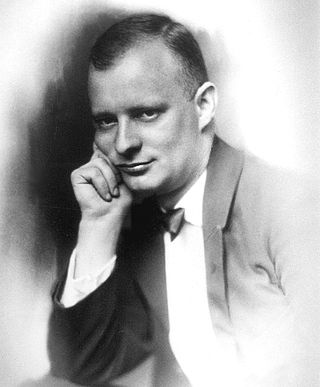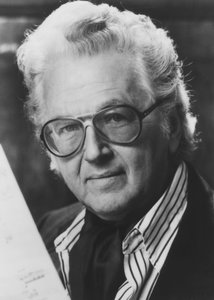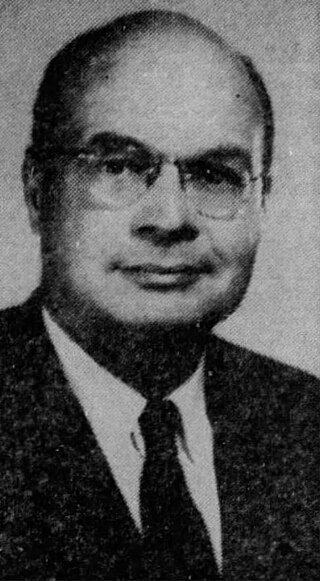Related Research Articles
A concerto is, from the late Baroque era, mostly understood as an instrumental composition, written for one or more soloists accompanied by an orchestra or other ensemble. The typical three-movement structure, a slow movement preceded and followed by fast movements, became a standard from the early 18th century.

Benjamin David Goodman was an American clarinetist and bandleader, known as the "King of Swing".

Paul Hindemith was a German and American composer, music theorist, teacher, violist and conductor. He founded the Amar Quartet in 1921, touring extensively in Europe. As a composer, he became a major advocate of the Neue Sachlichkeit style of music in the 1920s, with compositions such as Kammermusik, including works with viola and viola d'amore as solo instruments in a neo-Bachian spirit. Other notable compositions include his song cycle Das Marienleben (1923), Der Schwanendreher for viola and orchestra (1935), the opera Mathis der Maler (1938), the Symphonic Metamorphosis of Themes by Carl Maria von Weber (1943), and the oratorio When Lilacs Last in the Dooryard Bloom'd (1946), a requiem based on Walt Whitman's poem. Hindemith and his wife emigrated to Switzerland and the United States ahead of World War II, after worsening difficulties with the Nazi German regime. In his later years, he conducted and recorded much of his own music.
Although a concerto is usually a piece of music for one or more solo instruments accompanied by a full orchestra, several composers have written works with the apparently contradictory title Concerto for Orchestra. This title is usually chosen to emphasise soloistic and virtuosic treatment of various individual instruments or sections in the orchestra, with emphasis on instruments changing during the piece. It differs from sinfonia concertante in that it has no soloist or group of soloists that remains the same throughout the composition.

Mel Powell was an American Pulitzer Prize-winning composer, and the founding dean of the music department at the California Institute of the Arts. He served as a music educator for over 40 years, first at Mannes College of Music and Queens College, then Yale University, and finally at CalArts. During his early career he worked as a jazz pianist. His classic Big Band compositions include "Mission to Moscow", "My Guy's Come Back", "Clarinade", "The Earl", and "Bubble Bath".

The Trautonium is an electronic synthesizer invented in 1930 by Friedrich Trautwein in Berlin at the Musikhochschule's music and radio lab, the Rundfunkversuchstelle. Soon afterwards Oskar Sala joined him, continuing development until Sala's death in 2002.
The Viola Concerto by William Walton was written in 1929 and first performed at the Queen's Hall, London on 3 October of that year by Paul Hindemith as soloist and the composer conducting. It had been written with the violist Lionel Tertis in mind, and he took the work up after initially rejecting it. The concerto established Walton as a substantial figure in British music and has been recorded by leading violists internationally. Walton revised the instrumentation of the concerto in 1961, lightening the orchestral textures.

Ingolf Dahl was a German-born American composer, pianist, conductor, and educator.
Symphonic Metamorphosis of Themes by Carl Maria von Weber is an orchestral work written by German composer Paul Hindemith in the United States in 1943.

Leonard Bernstein's Sonata for Clarinet and Piano, written during 1941–42 and published in 1942, was Bernstein's first published piece. It is dedicated to clarinetist David Oppenheim, whom Bernstein met while studying conducting with Serge Koussevitzky at Tanglewood during the summers of 1940 and 1941.
A clarinet–violin–piano trio is a standardized chamber musical ensemble made up of one clarinet, one violin, and one piano participating in relatively equal roles, or the name of a piece written for such a group.
Arturo "Chico" O'Farrill was a Cuban composer, arranger, and conductor, best known for his work in the Latin idiom, specifically Afro-Cuban jazz or "Cubop", although he also composed traditional jazz pieces and even symphonic works.
Aaron Copland's Clarinet Concerto was written between 1947 and 1949, although a first version was available in 1948. The concerto was later choreographed by Jerome Robbins for the ballet Pied Piper (1951).

Igor Stravinsky's Violin Concerto in D is a neoclassical violin concerto in four movements, composed in the summer of 1931 and premiered on October 23, 1931. It lasts approximately twenty minutes.
The Piano Concerto in C is a concertante work by Ralph Vaughan Williams written in 1926 and 1930-31. During the intervening years, the composer completed Job: A Masque for Dancing and began work on his Fourth Symphony. The concerto shares some thematic characteristics with these works, as well as some of their drama and turbulence.

Kammermusik is the title for eight chamber music compositions by Paul Hindemith. He wrote them, each in several movements, during the 1920s. They are grouped in three opus numbers: Op. 24, Op. 36 and Op. 46. Six of these works, Kammermusik Nos. 2–7, are not what is normally considered chamber music – music for a few players with equally important parts such as a wind quintet – but rather concertos for a soloist and chamber orchestra. They are concertos for piano, cello, violin, viola, viola d'amore and organ. The works, for different ensembles, were premiered at different locations and times. The composer was the soloist in the premiere of the viola concertos, while his brother Rudolf Hindemith was the soloist in the premiere of the cello concerto. Kammermusik is reminiscent of Bach's Brandenburg Concertos, also concertos for different solo and orchestra instruments, and in a neo-Bachian spirit of structure, polyphony and stability of motion.
Clarinet Concerto No. 2 was the second clarinet concerto written by English composer Malcolm Arnold, his Opus 115. It was commissioned in 1974 by clarinetist Benny Goodman, who had given the American premiere of Arnold's Clarinet Concerto No. 1 in 1967.

The Concerti grossi, Op. 3, HWV 312–317, are six concerti grossi by George Frideric Handel compiled into a set and published by John Walsh in 1734. Musicologists now agree that Handel had no initial knowledge of the publishing. Instead, Walsh, seeking to take advantage of the commercial success of Corelli's Concerti grossi, Op. 6, simply combined several of Handel's already existing works and grouped them into six "concertos".
Konzertmusik für Streichorchester und Blechbläser, Op. 50, is a work by Paul Hindemith, composed in 1930. It was one of a large group of pieces commissioned for the 50th anniversary of the Boston Symphony Orchestra by its music director, Serge Koussevitzky. Koussevitzky conducted the premiere of Hindemith's work with the Boston Symphony Orchestra on 3 April 1931.

Klaviermusik mit Orchester, Op. 29, is a 1923 piano concerto by Paul Hindemith. Subtitled Klavier nur linke Hand, it is a piano concerto for the left hand alone. It was commissioned by the pianist Paul Wittgenstein, who lost his right arm in the World War. He never played the piece, and when he died, his widow refused access to the score. The premiere, after her death, was played in Berlin in 2004, with Leon Fleisher as the soloist and the Berlin Philharmonic conducted by Simon Rattle. It was published by Schott.
References
- ↑ "Benny Goodman Soloist with Student Concerts". The Philadelphia Inquirer . 3 December 1950.
- ↑ Barnett, Rob. "Paul Hindemith". MusicWeb International. Retrieved 13 July 2012.
- ↑ Stevenson, Joseph (2005). All Music Guide to Classical Music. Hal Leonard. p. 606.